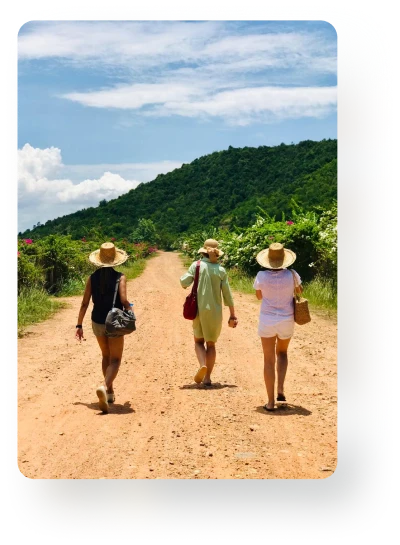XXPLORE
LAOS
DESTINATIONS
WHY TRAVEL
TO LAOS?

Get a taste of ancient Southeast Asia on your trip to Laos. Laos may be a landlocked country without a tropical coastline, but it makes up for it with stunning mountain scenery, lush rice paddies and the mighty Mekong River which runs through its territory. Still wild and largely untouched, it offers a fascinating array of cultural attractions, outdoor experiences and timeless charm.
As a small country in South East Asia, Laos has nearly 7 million people, but it has 130 ethnic minority tribes and divided into 4 language groups. By this reason Laos culture is really plentiful and diversified.
When it comes to planning a road trip in Southeast Asia, many travelers often overlook the hidden gem that is Laos. Nestled between Thailand, Vietnam, Cambodia, Myanmar, and China, Laos offers a unique blend of natural beauty, cultural richness, and warm hospitality.
The law provides equal rights for women and men and equal pay for equal work, and prohibits discrimination in marriage and inheritance, but the government did not enforce the law effectively. In some regions traditional attitudes about gender roles kept women and girls in subordinate positions and prevented their equal access to education, employment, and business opportunities. Varying degrees of culture-based discrimination against women persists, with greater discrimination practiced by some ethnic minority groups in remote areas.
The ideal months to visit Laos are from October to March with average temperatures at round 25C. The heat and humidity rise steadily from March onward, giving way to mon soon season in June.
The official language is Laotian, but in Luang Prabang and Vientiane English is widely spoken.
Lao Kip (LAK)
Laos Standard Time is 7 hours ahead of Greenwich Mean Time (GMT+7)
1. Temple hopping in Luang Prabang
2. Solve the mysteries of the Plain of jars.
3. Driving through stunning mountain scenery in Northern Laos
Larb is considered Laos’ national and most famous dish, larb is a minced meat ‘salad’ that be made with chicken, beef, duck, fish, pork or even tofu. The minced meat is mixed with plenty of fresh herbs, like basil or mint, and chilis along with fish sauce, shrimp paste, sugar and lime juice.
Naem Khao Tod or crispy rice salad, is a unique salad made with deep-fried balls of rice mixed with fermented pork sausage, grated coconut, peanuts, chilis, fish sauce and fresh herbs. The result is a flavourful mouthful that is traditionally eaten in a lettuce leaf as an appetiser.
Mo Pla is fish that is steamed with aromatics and sauces like lemongrass, kaffir leaves, and fish sauce in a banana leaf. Like larb, mok pla is also eaten with one’s fingers and a side of sticky rice.
Travelling
as a women
in Laos
Is it safe? In short, yes! Safety is a crucial aspect of any travel experience, especially for women embarking on road trips. Laos is known for its peaceful and welcoming environment, making it an ideal destination for female travelers or a group of women exploring the country. The locals are friendly and respectful, ensuring a sense of security throughout your journey.
BEST PLACES
TO VISIT IN
LAOS
Luang
Prabang
First inscribed as a UNESCO World Heritage Site in 1995, its heritage has been preserved in time and its traditions remain an enduring attraction. It’s still common to see locals give alms to monks each morning around 6am: sticky rice, crackers or cookies given as an act of charity to monks who rely on these expressions of good will.
Vien-
tiane
Home to 1 million people, Vientiane is the capital of Laos and has a cosmopolitan feel. The city has hundreds of international restaurants and triumphant memorials like the Patuxai war monument, erected to mark its independence from France. Incidentally, it was inspired by the Arc de Triomphe. Even though the capital city, it has a real relaxed feel to it.
Vang
Vieng
Surrounded by limestone mountains, stalactite-lined caves and sparkling lagoons, the town feels otherworldly and offers a plethora of outdoor activities: hiking, kayaking and zip-lining are just a few.
Muang
La
A few days in Muang La, surrounded by the gentle burbling of the Nam Pak River and the acres of unspoilt scenery, is guaranteed to send your shoulders south and your chill-factor north. As you wind through the green hills and rice paddies, it’s clear that life is unhurried and largely traditional: villagers spend their days tending to the land and hunting for food. In the evening, make your way down to the hot springs and join the villagers as they bathe in the warm water, float on bamboo rafts, and catch up with gossip from the neighbouring locales.
Cham-
pasak
Home to UNESCO-listed wonders, glorious jungle, and soaring waterfalls, Champasak is more than enough reason to head south in Laos. But the star of the show down here is the graceful ruin of Wat Phu Champasak. Often thought to be the blueprint for Angkor Wat, the temple was built at the zenith of the Khmer Empire. Framed by the Phou Khao Mountains and much of it covered in fragrant frangipani, the temple perhaps isn’t as large or gasp-worthy as Angkor Wat, but it’s soulful, fascinating and hugely worthy of a trip.

